Hey all!
If anyone is interested, here is a link to the e-Portfolio that I created at the end of the RCL course for our final project. It contains some highlights of my work from throughout the year.
Hey all!
If anyone is interested, here is a link to the e-Portfolio that I created at the end of the RCL course for our final project. It contains some highlights of my work from throughout the year.
For my final civic issues post, I will discuss the United States’ efforts in improving its relations with North Korea and Afghanistan. For North Korea, the United States is having to work with the Hermit Kingdom’s desire for nuclear weapons as well as the horrible atrocities that the government makes against its own people. The United States is having to balance North Korea’s desire for nuclear weapons with the security of Japan and of course, North Korea’s rival, South Korea. For Afghanistan, the United States still has troops present in the nation, however, plans are in place to pull troops out. Thus, the United States is working with the Afghan government on how the Afghan government can defend itself and it’s people. These two nations have provided many headaches for the United States as they threaten American interests.

The flag of the nation of the Democratic People’s Republic of North Korea
The United States has never been on good terms with the Democratic People’s Republic of North Korea, let alone been on neutral terms with the Hermit Kingdom. North Korea has always seemed to stand for the opposite beliefs that the United States believes in. North Korea has a dictatorship that is tightly controlling of their people while the United States has a government which serves the people. North Korea has labor camps which the government regularly places its own citizens in for misdemeanors such as being marked as a traitor, or not following the strict laws placed on the citizens. North Korea strictly censors its country, while the United States stands for no censorship at all whatsoever, and finally the United States stands for non-proliferation of nuclear weapons, while North Korea strives to create its own weapons of mass destruction (WMD). Japan, and South Korea are incredibly threatened by this development, because North Korea is incredibly hostile to both of these countries. Japan and South Korea are both very vital allies to the United States, thus the United States works with these countries to hold off North Korea from obtaining weapons of mass destruction. Thus, the United States is constantly in negotiations with the Hermit Kingdom on this issue of nuclear weapons. The United States has placed sanctions on North Korea in response to North Korea’s constant pursuit of nuclear weapons.
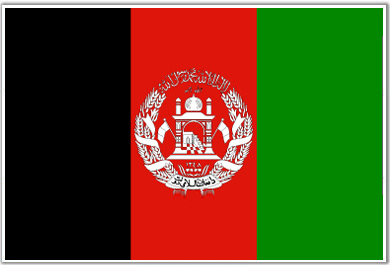
The flag of the nation of Afghanistan
The United States has been involved with the nation of Afghanistan since the 9/11 attacks in 2001. The government of Afghanistan, which was at the time controlled by the Muslim fundamentalist Taliban, was determined to be hiding members of the terrorist group Al Qaeda which was found by United States intelligence as the group responsible for the hijackings and the subsequent attacks on United States soil. The United States deployed troops to Afghanistan just a mere 2 months after the 9/11 attacks. The United States’ military’s objectives included toppling the Taliban government, which was responsible for harboring the Al Qaeda terrorists that planned the attack on the World Trade Center. The Taliban government was toppled, but the terrorists of the region remained in the rocky, cavernous mountains that inhabit the region. The United States military and other assets of the national security network have been working in the region for almost 13 years now, and the United States is finally pulling its forces out of the region. The United States has set up somewhat successfully a government for the nation, but the nation continues to come under attack by terrorist groups such as Al Qaeda or remnants of the Taliban that used to control the country. The country is doing the best it can in defending itself from these hostile forces, but its forces are poorly trained at times as well as disorganized. Thus, the United States still has its forces present in the country assisting and advising the security forces of the Afghani military and police. Afghanistan has made great improvements towards being a reputable country. It has held elections, and holds a stable government. Thus, you could consider Afghanistan as a victory for the United States.
Both of these countries provide unique challenges towards the United States, but the United States government has not failed in letting North Korea develop nuclear weapons, and has made strides in forming a successful government for Afghanistan. Thus, the United States has been relatively successful in its diplomacy with these two nations.
As most of you may know (from seeing me in uniform on Thursdays), I am a cadet in the Nittany Lion ROTC Battalion here on campus. What all of you do not know, is that I am an enlisted private in the Pennsylvania Army National Guard. I enlisted at the end of October, I completed MEPS (Military Entrance Processing Station), and I swore the oath to defend the Constitution of the United States of America (NOT the government). Through enlisting, I am ordered to complete Basic Combat Training (BCT) this summer as well as Advanced Individual Training (AIT). My MOS (Military Occupational Specialty) is 11B (called by military personnel, 11 Bravo) which is the code for the occupation of combat infantryman. I will be attending Basic Combat Training as well as Infantry School for AIT at Fort Benning, Georgia. Typically, BCT and AIT must be split into two different summers for those who must finish training by the end of the summer. However, with the 11B MOS, training is completed as OSUT (One Station Unit Training) which allows the recruit to stay at the same post for completing both BCT and AIT. This allows me to complete both BCT and AIT in the same summer, thus I will have all of the benefits of being enlisted by the end of the summer, because if I have not completed both of them, I will not be given the GI bill to help with my college tuition.
What will I be doing at Fort Benning you ask? I will be going through the training that thousands upon thousands of other recruits into the Army have experienced over the many years of the illustrious history of the United States Army. A typical day of Basic Combat Training starts bright and early at 0430 (4:30 AM) with morning PT (Physical Training) for 2 hours, then we go to breakfast. Breakfast will be eaten quickly and there will be no time for talking. After breakfast, recruits are sent back to the barracks to pick up any required equipment for the day’s training and then they form back up in formation to prepare for the morning’s training. At about noon, the recruits are either taken back to the mess hall for lunch, or are given MRE’s (Meals, Ready to Eat) in the field if the recruits are on a FTX (Field Training Exercise). After lunch, the recruits continue their training for the day, which could consist of learning how to perform D&C (Drill & Ceremony, marching, formations, and other formal things essentially), STX (Situational Training Exercise, battle drills and squad tactics), and even sometimes various obstacle courses. Although “PT” formally ends at 0630 that morning, PT really continues throughout the day as most training is physically challenging, and also on top of this, random “smoke sessions” could occur. Getting “smoked” is when one person in the platoon makes a mistake and the drill sergeant determines that the offense is large enough that he puts the entire platoon into formation, and has the formation do push-ups, flutter kicks, leg raises, and anything else that the drill sergeant deems fit until the punishment has fulfilled the mistake that has been made. Finally, after a full day of training, the recruits are sent back to the mess hall for dinner, and then the recruits have personal time in the barracks for resting. At 2100-2200 (9:00-10:00 PM), the drill sergeant declares lights out, and the recruits are sent to sleep. This will be my “day at the office” for 4 months. My estimated completion date for training September 5, and from there I will return to school to start the Fall 2014 semester.
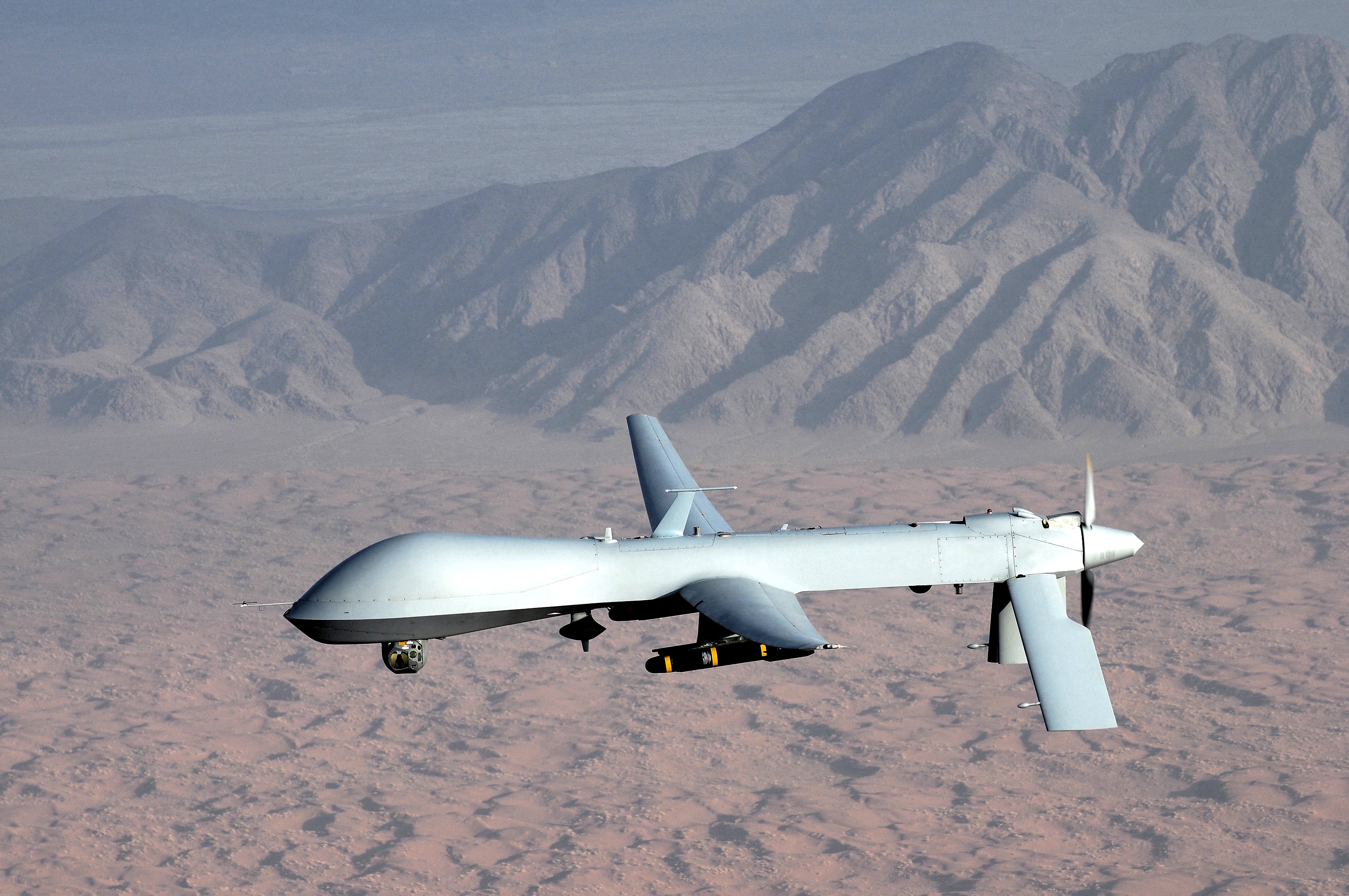
MQ-1 Predator drone (equipped with Hellfire air-to-surface missiles under the wings)
A few days ago, I found an article about how the Kingdom of Saudi Arabia has joined the world’s elite club of having an armada of armed, combat UAV’s (Unmanned Aerial Vehicles) added to their military. This elite club of combat UAV equipped militaries consists of those of nations of the United States of America, Britain, China, Israel all and some say reportedly that Iran has their own armada of UAVs. UAVs are flying drones that can be remotely piloted for surveillance and spying. Some models owned by the militaries of the United States, Britain, China, Israel, and possibly Iran, also can be equipped with air-to-surface missiles such as the American Hellfire missile. The ruler of the Kingdom of Saudi Arabia, Crown Prince Salman purchased these UAVs from the Chinese government. Saudi Arabia purchased a shipment of Wing Loong drones, also known as “Pterodactyls”.

The Wing Loong “Pterodactyl” UAV
These Pterodactyls mimic the American MQ-1 Predator drone, which is equipped with surveillance systems as well as can be equipped with two matched air-to-surface missiles.
However, unlike the Predator drone which has been battle tested over the skies of the Middle East in the airspace of countries such as Afghanistan and Yemen, the Pterodactyl has not been combat tested. Thus, it has yet to be seen whether the Pterodactyl actually has the combat abilities that the Predator drone has.
So how has the United States become not the only nation that has combat ready unmanned drones? International trade is the biggest factor. For example, Israel developed an armed drone and in the past 7 years has exported $4.6 billion in drone systems. Although the United States is the principal user of combat UAVs, and the world has been observing the United States military to see how effective the combat drones have been in taking out their targets, and demoralizing the enemy. Also, another concern the world has been watching the United States is how often collateral damage of innocent civilian casualties occurs. And as the world has seen, the combat UAVs that the United States fields are very effective at their task, with several HVT’s (High Value Targets) have been eliminated through the use of Predator and Reaper (upgraded model of the Predator) drones. However, collateral damage through innocent civilian casualties often occur too. Other nations have determined though that the effectiveness of combat drones are worth the risk.
Another incentive for nations to use the combat UAVs like the Predator or the Pterodactyl is that they are cheaper to operate than jet fighters. UAVs need less systems since no pilot is actually in the cockpit, no systems are needed to keep the pilot alive. This results in lower cost of production and less fuel necessary to fly the drone the same distance as a jet fighter, thus equaling a cheaper price to fly the drone. Also, drone pilot training is much cheaper than training a fighter pilot. With a fighter pilot, the pilot requires not only flight training, but also requires training on how to deal with the G forces (physical forces that impact the pilot during high speed maneuvers), survival training (in case the pilot is shot down), resistance to torture and escaping enemy forces training (for evading enemy forces and if captured, resisting torture if shot down). All of this training for the jet fighter pilot, in comparison to training for the drone pilot only consisting of flight training on how to operate the drone. Also, with the danger factor that is included with the jet fighter pilot, if a fighter pilot is killed in action, then the government must pay a great amount of money to train a new fighter pilot to replace the one who was killed in action. However, with the drone pilot, there is no danger involved and no risk of the drone pilot being killed in action, thus there is no danger of the military having to spend the money to replace the pilot due to the death of a previous pilot.
In the end, the group of nations who have militaries who possess armed unmanned aerial vehicles will only continue to grow as countries sell and trade technology that is required to develop their own models, and as countries realize that all around economically and militarily, drones are the much better option than jet fighters have ever been.
To read more on this topic, check out the article that inspired me to write this blog post!
For this passion post, I thought that I would write on a great inspiration to me, as well as many other members of the various ROTC units here on campus. If you’re a Penn State student (which I’m assuming you are since you are reading this blog), then you’ve probably heard the name “Michael Murphy” or “Murph” or “The Protector”. These are all names for Lieutenant Michael Murphy, who graduated from Penn State, and subsequently right after graduation accepted a commission to be an officer in the United States Navy in the hope of attending the school necessary to become a U.S. Navy SEAL. He completed officer school, attended and graduated from BUD/S (Basic Underwater Demolition/SEAL) training, and completed all necessary training to become a U.S. Navy SEAL. After completing his training, he was deployed to first Jordan, and several other locations within CENTCOM (CENtral COMmand, the Department of Defense’s code name for the Middle East area including Egypt) before he was deployed to Afghanistan with SEAL Delivery Team ONE. As an officer, he was deployed as a platoon leader within the team.

LT Murphy when deployed to Afghanistan
Once deployed to Afghanistan, LT Murphy was given a mission known as Operation Red Wings, which would be carried out as a reconnaissance mission to cover an area which was known to be hiding a HVT (High Value Target) member of the Taliban. He was given a team of 3 other SEALs to complete the mission. The SEALs reached their reconnaissance position, they found that the area actually was holding a higher number of insurgent forces than they were informed in the intelligence that they had been given about the area. But, they decided to stay anyways in order to continue the mission. However, after a little time a couple of goat herders who were moving through the mountains. The SEALs knew that the goat herders would be sympathetic to the Taliban insurgents that were down below in the valley. The SEAL team grabbed the three goat herders and the team had three options: they could leave the goat herders tied up and have them possibly die to the elements, shoot the goat herders so that they will not have any chance of being exposed, or release the goat herders and risk alerting the insurgents below. LT Murphy, being the ranking SEAL on the team, decided for the team that they would let the goat herders go free. The SEALs had a pretty good idea that the goat herders would tell the insurgents down below that the SEALs are located in the mountains, thus the SEALs started moving out towards to the original location in order to run from the Taliban that they knew would be hot on their tail soon. After moving out for a while, the SEALs realized that they had been cut off by the Taliban. They are eventually spotted, and a firefight ensues. In the firefight, 3 of the 4 SEALs are killed, and LT Murphy is one of the 3 killed. LT Murphy was awarded the Medal of Honor for an action on the mountain. He was awarded the Medal for moving onto an exposed location to use the satellite phone that had been given to them to contact the headquarters for support. In doing this action, LT Murphy was killed in action. After this action, reinforcements were called in, however the helicopter was shot down and everyone aboard was killed. The remaining SEALs retreated as far off of the mountain as the could with 2 other SEALs being killed in action during the retreat. Only one survived the retreat off of the mountain, Marcus Luttrell escaped the mountain, and was the only SEAL to be rescued. In the end however, LT Murphy will always be remembered for his heroic action to get his support and to help his men. He will always be remembered as a great Penn Stater with an indomitable spirit.
Near the beginning of the semester, I wrote a post on how the United States and the 21st Century in comparison to the United States and 20th Century, which many consider to be the “American Century”. I wrote how the United States was affecting two current international diplomatic situations. I wrote about the Ukrainian protests, and the Iranian nuclear negotiations. In this post, I will discuss how the United States is doing with diplomacy, and with that I will discuss the United States’ relations with China and Russia. I will discuss the United States’ relations with China and the events that have led to our current relationship with the Middle Kingdom. I will also do the same with Russia and I’ll discuss the events that have led up to our current relationship with Russia.

The national flag of China
One could argue that our relationship with China has grown less hostile over the years. However, our relationship with China is still relatively cold due to the fact that China is our main economic competitor and because although China has grown more capitalist over the years since its formation, the People’s Republic of China is still a communist state with limited democratic involvement with the people, rampant bribery, and commonplace cases of abuses of power. Even in recent times, China has made some aggressive moves against the United States. Over the past two years, China has declared “cyber war” on the United States, with reports stating that several key infrastructures of the United States government have been infiltrated by Chinese hackers. Some of these infrastructures include the Department of Defense at the Pentagon, the State Department and frameworks of the American economy. According to a report last week by the Commission on the Theft of American Intellectual Property, a group headed up by two ex-Obama administration officials (Dennis Blair and Jon Huntsman), hacking costs the U.S. some $300 billion per year. And you know what? China is reportedly responsible for a full 70 percent of that when it comes to corporate IP and theft. And as much as the Chinese hacking puts the Department of Defense on edge in regards to cyberwarfare and compromising national security, but currently at the moment American business and industry is mainly being affected by Chinese cyberwarfare. But what does the public think about all of this? Many Americans are just worried about getting through what has been the biggest recession in decades. In fact, many are pleased with how the United States has made somewhat significant moves towards being cordial with the Chinese government. Although China has made aggressive moves, one could say that the United States has maintained a level head in the situation and is continuing to work with China on improving relations with one another.

United States Cyber Command is the Department of Defense’s program to shield against cyberwarfare threats such as those which are coming from China.

The national flag of the Russian Federation
Although China is subversively being aggressive towards the United States, Russia on the opposite hand is being overtly aggressive towards the United States wishes. Recently, Russia used the cover of the Ukraine political turmoil to insert pro-Russian sentiments into the Crimean region. By providing support to the separatists who wanted to merge with Russia and separate from Ukraine, Russia politically trampled the national sovereignty of Ukraine. Russia provided aid to the separatists, and it is even rumored that Russia inserted Russian special operations forces (a.k.a. Spetznaz) into the region to assist the separatists as well as provide some unconventional military support. Then, after several weeks of turmoil in the Crimean region, uniformed, unidentified gunmen appeared and took over the Crimean government, as well as harassed the Ukrainian forces in the region. Eventually, these gunmen essentially controlled the region, and then Russian military forces moved into the region to solidify control. Through this whole situation, the United States and various European leaders were protesting Russia’s actions. Despite the United States placing sanctions on Russia (and considerably damaging Russian-American relations), Russia continued its hostile takeover of the Crimean region of Ukraine. The United States has not been very effective in this situation, as although the United States has held solid on its threats against Russia, Russia has continued to commit to the offending actions of meddling in Ukraine’s sovereign national territory.
Whenever a military historian or someone who is familiar with much of World War II thinks about airborne (military parachuting) operations, it is often inclined to the person to think first about D-Day (Operation Overlord, which I discussed two weeks ago in a Passion post). However, there were several other airborne operations throughout the war between the Allies and the Axis. Although there were some airborne operations in the Pacific theater of the war, most of the notable operations took place in the Europe theater of the war. One of these European theater airborne operations was Operation Market Garden. Operation Market Garden was led by Field Marshal Bernard Montgomery, whose objective of the operation was to punch a hole through the northern portion of the Siegfried Line (Germany’s defense line on the border of France, the Allies had liberated all of France at this point), through the Netherlands in order to push through Germany from across the Lower Rhine into the industrial heartland of Germany which was to the southeast of where the airborne drops took place in the Netherlands.

Waves of paratroopers landing in the Netherlands; most were veterans of the D-Day airborne operations
Operation Market (Market-Garden is actually two operations spliced into one. Market being the airborne phase of operations, and Garden being the armored advances that would support the airborne operations) was the largest airborne operation ever to take place in military history, delivering 34,600 paratroopers, and another 14,589 glider troops. However, the reason why this operation is not focused on by military historians as much as D-Day is because Operation Market Garden was an operation failure for the Allied forces, while D-Day is remembered as the Allies’ triumphant, yet bloody entry into Fortress Europa (nickname for Hitler’s occupied Europe). Thus, why D-Day is remembered with great importance, while Operation Market Garden is neglected as a topic of discussion among many military historians.
The operation began with a smooth beginning, with paratroopers landing into the Netherlands with little resistance, and actually caught the German troops and their commanders off guard.
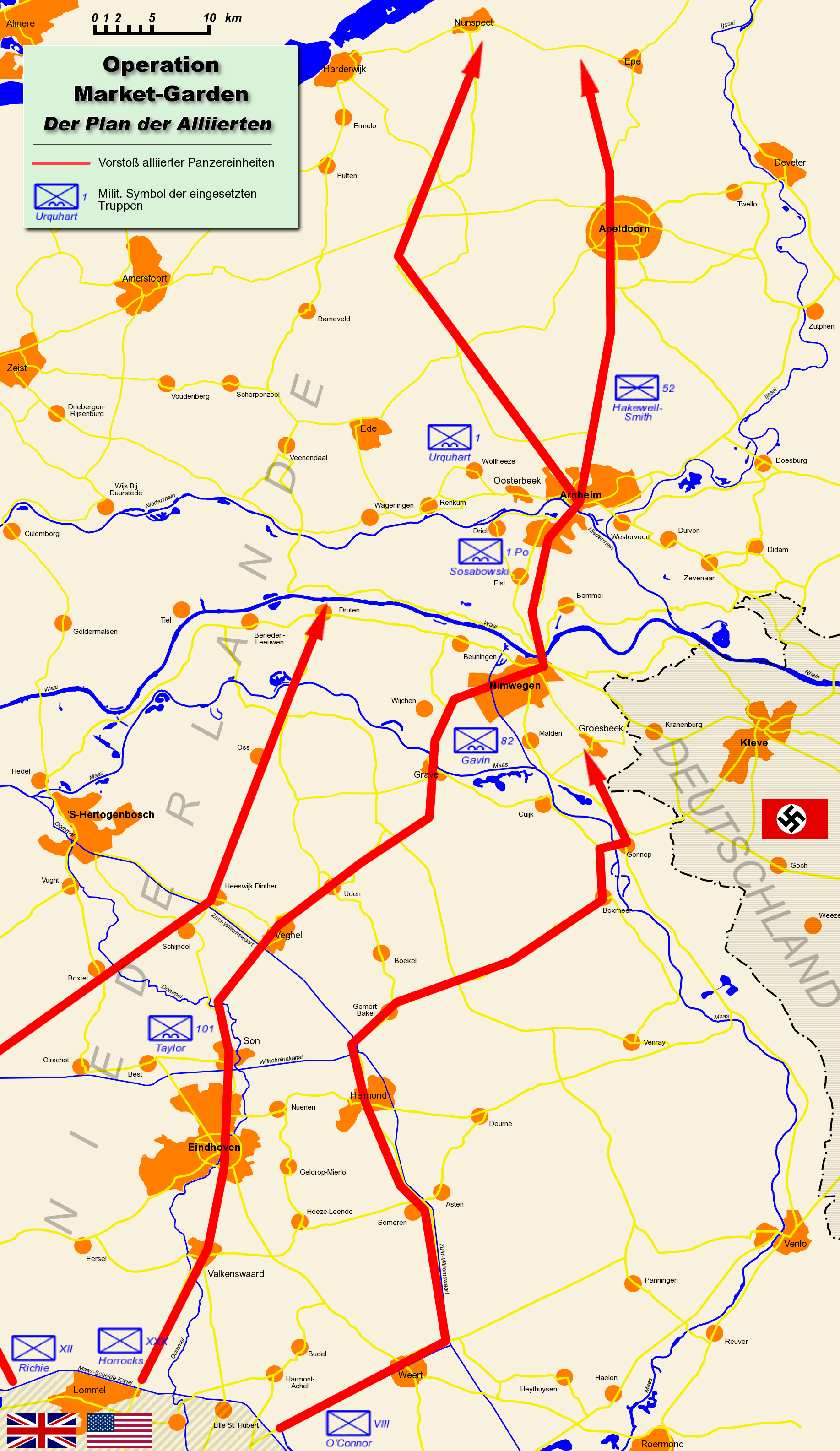
The Allied plan of movement for Operation Market Garden. The blue squares are troop markers for different units, and the red arrows are the plan for how those units would move.
The operation went smoothly as the Allied troops pushed towards the Rhine. However, the German troops were able to regroup at the bridges were the objectives of the Allies, and put up a stiff resistance against the Allied troops. The Axis troops held the Allies at the bridges, and the Allies were not able to advance over the Rhine. One particular bridge that the Allies were attempting to advance over, the Arnhem bridge, ended in absolute failure. The assault on the bridge went from attempting to overcome the bridge defenders, to fighting for their lives. Most of the remaining British paratroopers that were left from the German onslaught surrendered and became POW’s (Prisoners of War) of the German troops who captured them. The last message that the British who were at Arnhem sent out on the radio (which was only heard by the Germans reportedly) was “Out of ammo. ‘God save the king’.”
As the largest airborne operation of all military history, it is amazing how Operation Market Garden is not discussed more from an analyzing standpoint on how the Allies could have been more effective in their assault. Also, in analyzing how the largest airborne operation in military history was conducted.
The War on Terror rolls on today in 2014 after 13 years of warfare. Through these 13 years, the technology of war has advanced as the United States’ government has pushed a large budget towards the defense industry which has taken the money to improve its capabilities in defending the United States against terrorist networks such as Al-Qaeda and its affiliates (Al-Shabab, Abu Sayaaf, Somali and Filipino branches of Al Qaeda respectively). One of these military technological developments is the development of various multipurpose flying drones. These drones can take photographs of targets, laser target objectives for laser-guided munitions from other aircraft, and even with later developments to the technology, the drone itself could carry and deliver lethal munitions with precise accuracy to the target.
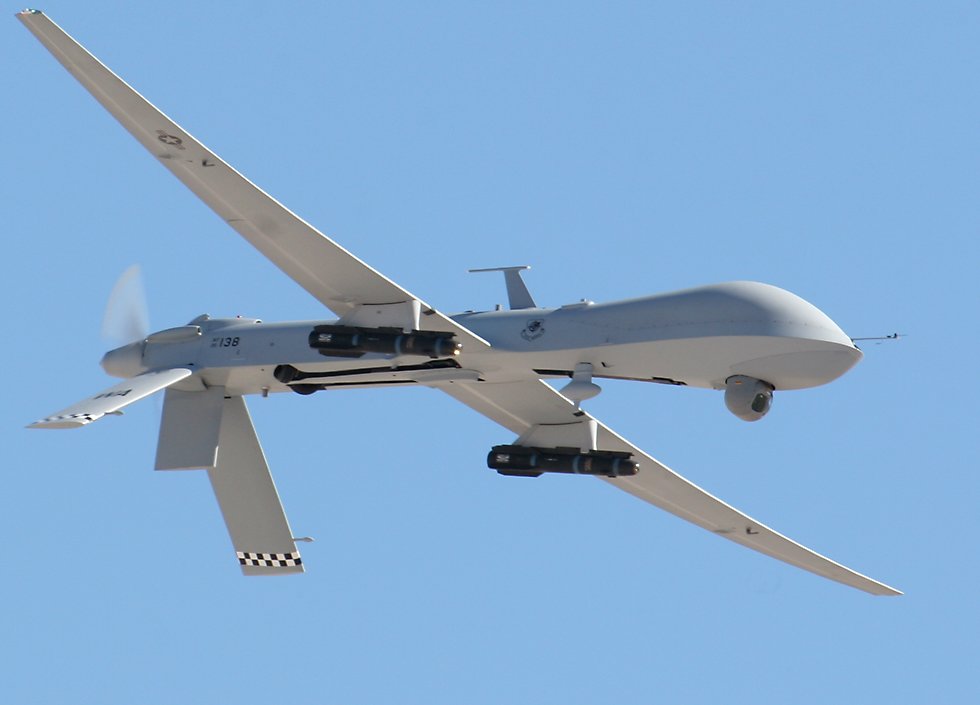
An Air Force MQ-1 Predator Unmanned Aerial Vehicle (UAV or A.K.A. a drone) The Predator drone shown here has been armed with Hellfire air to surface missiles.
The Air Force has grown incredibly reliant on drones to complete missions, and the reason why the debate on drones has been started is the government has begun to use drones over countries that are not in conflict with the United States, but are known to hold terrorist strongholds. Examples include, Somalia, Libya, Algeria, Yemen, Pakistan, North Korea and Iran. The drones over these countries spy and even sometimes destroy high value targets that are in the sovereign territory of these nations even though the United States is not at war with these countries. The debate about this drone policy is the use of these drones can be seen as an act of war, and is what many would consider as technically illegal in the eyes of international law as the United States many times does not ask for the country’s permission in using these lethal spy drones over the country’s sovereign airspace to photograph the area or to engage a high value target that may be in the area.
Another facet of the debate over the legality of drones is there are many cases of drones initiating a missile strike and the destruction causes excessive collateral damage, because targets often live among villages or other areas of high terrorist activity. These innocent casualties are the face that the countries that we infiltrate with our drones use as news fodder to promote hatred against the United States’ policies and as a face to their objection to the ignoring of their sovereign airspace by the United States and its military. Pakistan in particular is extremely agitated by the activity of American drones over its western tribal lands. As much as the Pakistani government desires to degrade the Taliban base of operations in this western frontier of sorts for Pakistan, the Pakistani government would still desire to take care of the threat itself, not with any American aid, especially when this aid is given without asking.
The debate also is a hot area also for some Americans, because the government has ruled that in the interest of national security, the government has the legal right to eliminate an American who is deemed as a threat (terrorism related or not). This angered many (rightfully so in my opinion) and invoked thoughts to many of a 1984 Orwellian “Big Brother is watching” scenario of where the government could eliminate any American as a target whenever the government would decide to eliminate them.
Although these are the arguments against the American policy of drone use, many, including some citizens of the countries that are being infiltrated by these drones, are approving of the CIA and Air Force’s use of drones. For example, in the tribal lands of Pakistan that I have mentioned earlier in this post, several surveys have shown that many approve of the drone strikes and would prefer more drones in the skies above them. They find the laser guided missile strikes much more effective than the artillery barrages of the Pakistani military’s effort to drive out the terrorist forces from the area. Opposite of mainstream Pakistani opinion, many of those who live in the tribal lands believe that the drone strikes do not kill many civilians in unfortunate collateral damage.

The Federally Administered Tribal Area (FATA) is the largest base of operations for the Taliban and Al Qaeda forces that plague Afghanistan as well as other places around the world.
The pros and cons of drone warfare and drone surveillance are both valid in their own ways, and it would be difficult to come to a conclusion on which side is more right. I believe that the use of drones is vindicated, but it is up to the public to be mindful and wary of the government abusing its “toys” to eliminate targets which don’t even benefit the War on Terror anymore, but are just used as the President’s flying, robotic, stealth assassins. As with many things in this great country, it is up to the people to be wary of the government’s doings, and to police them with the voice of the people.
During the break, I decided that I would now focus my Passion blog posts on historical events from World War II, because I found it too hard to find historical events that happened to coincide with the day and that had an abundant amount of info online to support writing on it. Thus, for my continuation from my first passion blog post which was on the Battle of the Bulge, I decided to discuss D Day, the largest amphibious invasion in history. I will also discuss the airborne operation that was also behind D Day’s successful landings.

“Into the Jaws of Death” by photographer Robert F. Sargent. Arguably the most famous photo from the D Day landings.
After being postponed several times, the D Day landings finally took place on 6 June 1944. The landings were the largest in history and it was the invasion that broke through Hitler’s Fortress Europa. The invasion began with airborne and glider troops landing behind the beaches and sabotaging any efforts that might have been used to hamper the landings. The airborne troops were landed to cut off any reinforcement efforts that the Germans made to counterattack the beach landings. About 15,000 paratroops and glider troops were landed behind enemy lines to hamper the German defense effort.

A C-47, the standard workhorse which was used to deploy airborne troops into battle
As much resistance as the airborne units put up, the Germans were still able to bring some reinforcements up to the beaches. Before any of the landings occurred, the Allies launched the largest naval bombardment campaign that has been seen in history. Destroyers and other naval ships of war pounded the beach defenses with their guns. However, as the infantry that land would soon find out, some beach defenses were more sabotaged by the naval fire than others. The Allies also launched a massive bombing campaign against the beach defenses, using mainly fighter bombers to attack the targets.
Once the naval and air bombardment ceased on the beaches, the infantry finally made their landings. There were 5 beaches: Omaha, Utah, Gold, Juno, and Sword. The Allies split up and covered each of the different beaches. The United States forces were responsible for Omaha and Utah, the United Kingdom’s forces were responsible for Sword and Gold, and finally Canadian forces were responsible for the landings at Juno. The landings at Utah had the lightest casualties, meanwhile Omaha had the heaviest casualties. Out of the British-Canadian forces, Juno, the Canadian landings took the second heaviest casualties out any beach.
Although the Allies would lose 10,000 casualties (dead and wounded) in the single historic day which was and is D Day, the Allies would prove victorious for the day in their valor and force of will in capturing each of the beachheads. These landings would prove the beginning of the end for Hitler’s Nazi Third Reich. From these landings, the Allies would continue to push forward throughout France, into the Low Countries, and eventually even into Germany where the Allied forces would force the unconditional surrender of Germany
I decided to go in a different direction for this week’s blog post and I will be talking about an event that happened in history today, February 11 in 1854. The event is when Commodore Matthew C. Perry and his two warships entered the Japanese port of Edo in order to sign a treaty with the Japanese which would allow the Americans to have a relationship of trading and friendship with the Japanese. This treaty would allow the United States to become the first Western power, besides the Dutch, which would gain a trading relationship with the “closed country” of Japan. (Japan had a policy of “sakoku” which means “closed country” in Japanese)
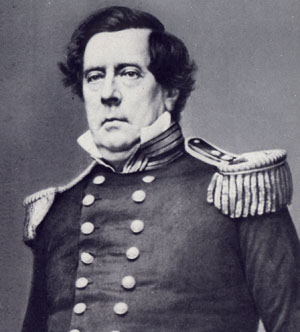
Commodore Matthew C. Perry
The talks with the Japanese began with President Millard Fillmore sending Commodore Perry on an expedition to Japan in 1852. The voyage embarked from Norfolk, Virginia for Japan in search of a trade treaty. Commodore Perry was armed with a letter from the President, informing the Japanese of the United States’ desire to have a trade alliance with Japan. Before his venture to the Land of the Rising Sun, Commodore Perry studied the Japanese from many sources. Commodore Perry even researched a German Japanologist who had lived at the Dutch trading post for 8 years. When Commodore Perry and his ships reached Japan, delegates from the Tokugawa Shogunate (the shogun administration which led Japan at the time) who directed Perry to the port of Nagasaki, which was the port open to foreigners at the time. Instead, Commodore Perry ordered his ships to steam past the Japanese lines towards the capital city of Edo and position their guns towards a smaller town nearby. This was a show of force to the Japanese that the American ships were a force not to be trifled with. He then demanded that he deliver the letter from President Millard Fillmore to the Shogunate, and that if the Japanese ships surrounding the American squadron did not disperse then he would be forced to attack. The American ships were equipped with new naval weapons which could fire shells that would explode on impact. With the Japanese being cut off from the rest of the world, they did not have the technology to combat such an advanced piece of military technology. After the Japanese agreed to receive the letter, Commodore Perry landed at Kurihama to deliver the letter to the delegates who were present. He then left for his ship, which he took to the Chinese coast, and he promised that he would be back for a reply. Meanwhile, the Japanese built fortifications outside of their capital city’s port in order to prevent any further American naval incursion. Perry returned in February of 1854 to receive the treaty with twice as many ships in his fleet to ensure that all demands were met in the letter that was sent by the President.

The Fleet Led by Commodore Perry in 1854
On March 31, 1854, Commodore Perry signed the Convention of Kanagawa which gave the United States trading rights with the Shogun, the de facto ruler of Japan.